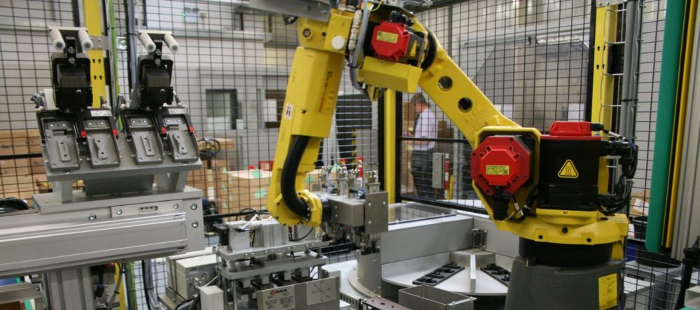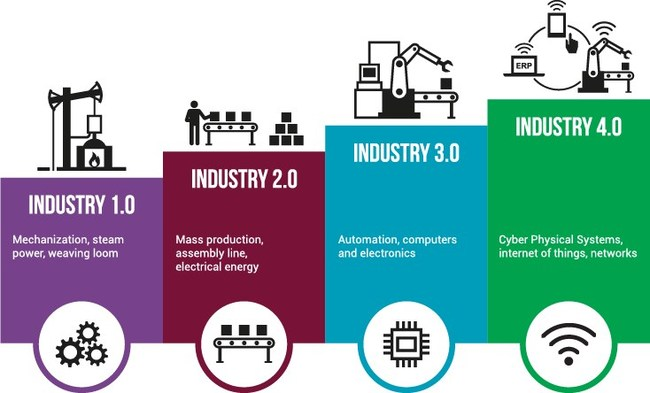
With automation, an organisation can undertake processes with little or no human interaction. Automation controls a range of equipment, which can then complete a variety of objectives in numerous manufacturing environments.
Automation has the ability to increase quality, effectiveness and efficiency by reducing human assistance, therefore reducing the risk of error.
In its basic form, automation utilises a controller which compares a measured state against a list of values, adjusting this state to maintain the desired environment and conditions.
A Brief History
It’s easy to think of automation as the combination of computers working with electrical, mechanical, hydraulic and pneumatic devices.
However, before the input of electrical intervention, automation involved simple mechanical controls; now though, automation utilises electronic and computer controls, running on sophisticated programming language.
Automation, in general, has both contributed to and detracted from the well-being of the planet and individuals. For example, automation developed dramatically during the Industrial Revolution and was responsible for the mining of fossil fuels such as coal.
These activities have significantly harmed the natural world and the health of humankind. However, what’s known as the fourth wave of automation, could be automation that rights these wrongs through electric cars, smart homes and green energy.
Automation in Industry

Automation in industrial solutions uses a control system (such as a computer) and large data sets to manage the equipment and process within a manufacturing setting. Production and manufacturing environments are increasingly relying on automation to boost output, productivity, and efficiency, by using a specific variation that never drifts from the measured state we mentioned earlier.
Automated production lines will consist of workstations and a transfer system that moves something through a process of change using a series of tools. Some parts may also need to be moved across to another production line to be completed. The logic controller will manage this work and transfer by controlling the timing and the sequencing of the equipment.
Businesses will use automation solutions for manufacturing, refining, and producing individual parts, as well as the assembly of the finished product.
An automation infrastructure encompasses the collection of buildings, utilities, tools, processes and products required to create an item or range of related items that eventually make a whole.
Different Kinds of Factory Automation Systems
There are four different kinds of automation in use, each one serving a specific purpose:
Computer- Integrated Manufacturing (CIM)
Computer-integrated manufacturing automation describes the automation of all factory-related and production processes through computer systems. CIM systems will frequently include the following:
- Automated cranes and transfer systems.
- Numerical control machine tools.
- CAD (computer-aided design) and CAM (computer-aided manufacturing).
- Computer-aided planning.
- Computer-aided scheduling and production.
- Dynamic machine systems.
- Robotics.
Flexible Manufacturing Systems (FMS)
Using a flexible automation system means that factories will have the ability to extend the capabilities of programmable systems to enable the changeover with no or limited loss of time in production. Medium-sized operations are the ideal scenario for a flexible system.
Programmable
Programmable automation systems allow for the adaptation and reordering of entire manufacturing processes to account for deviation and customisation of the intended finished item. These solutions will often utilise numerical control machine tools run on a computer program to produce the different variations of the product in batches. These can range from just a few to thousands of object variations.
Although exceedingly efficient, programmable automation means that time must be taken to change hardware and reprogram controls in between batches.
Hard, Rigid or Fixed
In fixed automation systems, as the name suggests, the equipment dictates how the processes play out, and they cannot be changed without a good deal of effort. In this case, the output is generally limited to a single product in high volumes, such as car manufacturing.
Factory Automation Tools
Numerical Control
This was once previously performed by skilled machinists, who would punch instructions into a card to run numerically controlled machine processes. These days, these directions are translated into electrical signals that guide settings like tool selection, movements, and spindle speed.
Computer Numerical Control
Using a computer processor in conjunction with numerical controls means that it is possible to store, edit and review coded programmes, in the case that errors occur.
Automation Controls
Automation tools rely on a rotation table and access that allows parts and tools to move within three axes – vertical and horizontal, and another vertical in the third plane. Modern machinery can have as many as nine axes.
CAD & CAM

image from solidedge
Computer-aided design uses a computer to create objects visually. Once a final design is compiled, it can be entered as a program and sent to a computer-aided manufacturing system. CAM systems are platforms that include all facets of process, production, scheduling, machinery, and quality control planning.
Programmable Logic Controllers (PLCs)
The computer numerical control we’ve mentioned is only possible due to the programmable logic controllers. These are hardened microprocessors that integrate and complement signals coming from the sensors with instruction actuators. The interface principally serves as the face of the PLC, thereby allowing a user to program and monitor tasks and process.
Islands of Automation
Before advanced communication protocols such as Ethernet and Modbus were commonplace, systems weren’t able to communicate with each other in the same way that they do today. The term Islands of Automation refers to an automated system in an otherwise manual factory setting. Islands of automation eliminate the requirements for inline buffers and allow for swifter product changeover.
Inline Assembly
Inline assembly systems work to produce large amounts of one kind of product with minimal variation, therefore minimising product changeover. As such, this system requires much less human effort and makes planning a far easier task.
Industry 4.0

Image from newswire
Industry 4.0, also known as smart manufacturing or the fourth industrial revolution, is the use of data and automation in manufacturing scenarios. The highly intuitive and interconnected nature of the Industry 4.0 revolution adds the dynamism required to keep up with the demanding requirements of a market that involves more customisation than ever before.
In an Industry 4.0 setting, a previously standalone activity can now connect with other processes with unprecedented speed to add value to the entire operation.
Industry 4.0 is comprised of nine pillars of technological advancement, below we’ve highlighted each one and their function:
Additive Manufacturing
Additive manufacturing is essentially another name for 3D printing, which creates objects through 3D technology, by creating layers which eventually build up the form of an object. This technology is ideal for experimental prototype work, small batches of custom products, and lightweight parts.
Augmented Reality
This technology is incredibly beneficial for troubleshooting problematic areas in machines, training and diagnostics and repairs during service calls.
Autonomous Robotics
Autonomous advances have further increased the capabilities of robotics, giving them the ability to change their objectives based on what point the production process is at. In addition to working safely with humans, robots are also capable of communicating with each other.
Big Data & Analytics
Massive quantities of data and analytics need to be collected to produce greater quality, time-after-time. Companies will be able to collect data at every stage of the chain to improve processes and redeploy resources elsewhere, such as predictive maintenance.
The Cloud
Connectivity in manufacturing requires collaboration beyond facilities and company boundaries. Fast cloud computing allows for data collection, analysis, storage and monitoring.
Cybersecurity
Industry 4.0, at its core is about moving away from closed processes, toward efficient connectivity, that will require higher levels of user-access and greater network cybersecurity.
Horizontal and Vertical System Integration
System integration is the complete harmonisation of all entities along the supply chain. For example, producers may wish to receive supply chain information from retail organisations and the manufacturing department to ensure they are keeping a close watch on all processes.
Internet of Things (IoT)
IoT sensors are present within many devices along the production line and in control centres. These devices are then able to interact with each other to provide in-depth data on the production process, which can be analysed by operators, sent to the cloud and used in predictive maintenance.
Simulation
3D simulations of products, materials and production procedures can take real-time data and convert it into a virtual model of the entire production operation. Enhanced simulation also allows users to test and optimise tool settings to achieve maximum productivity.
If you require any further information about anything we’ve covered in this piece, or you’re interested in any of our other solutions, then why not contact us today?
